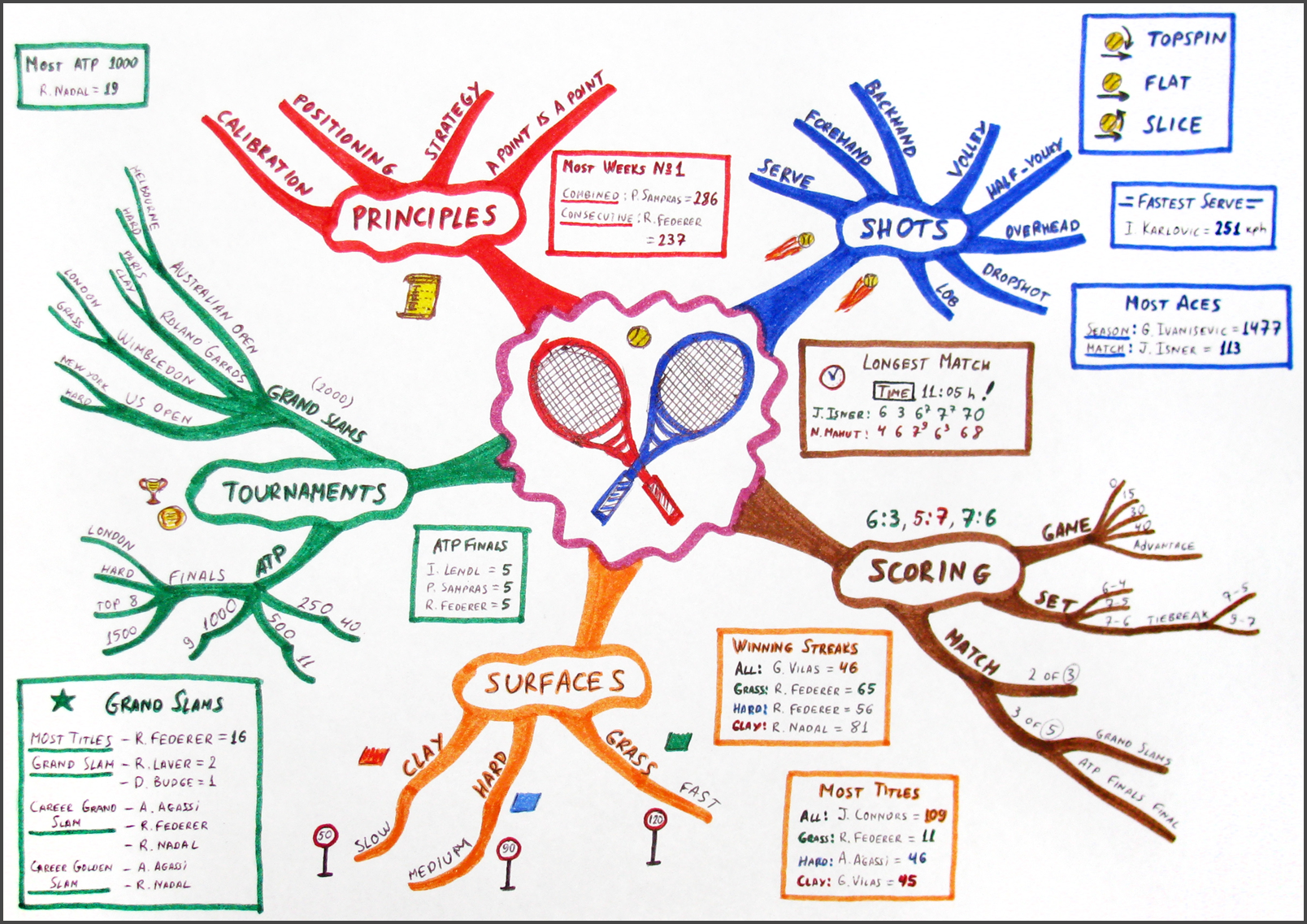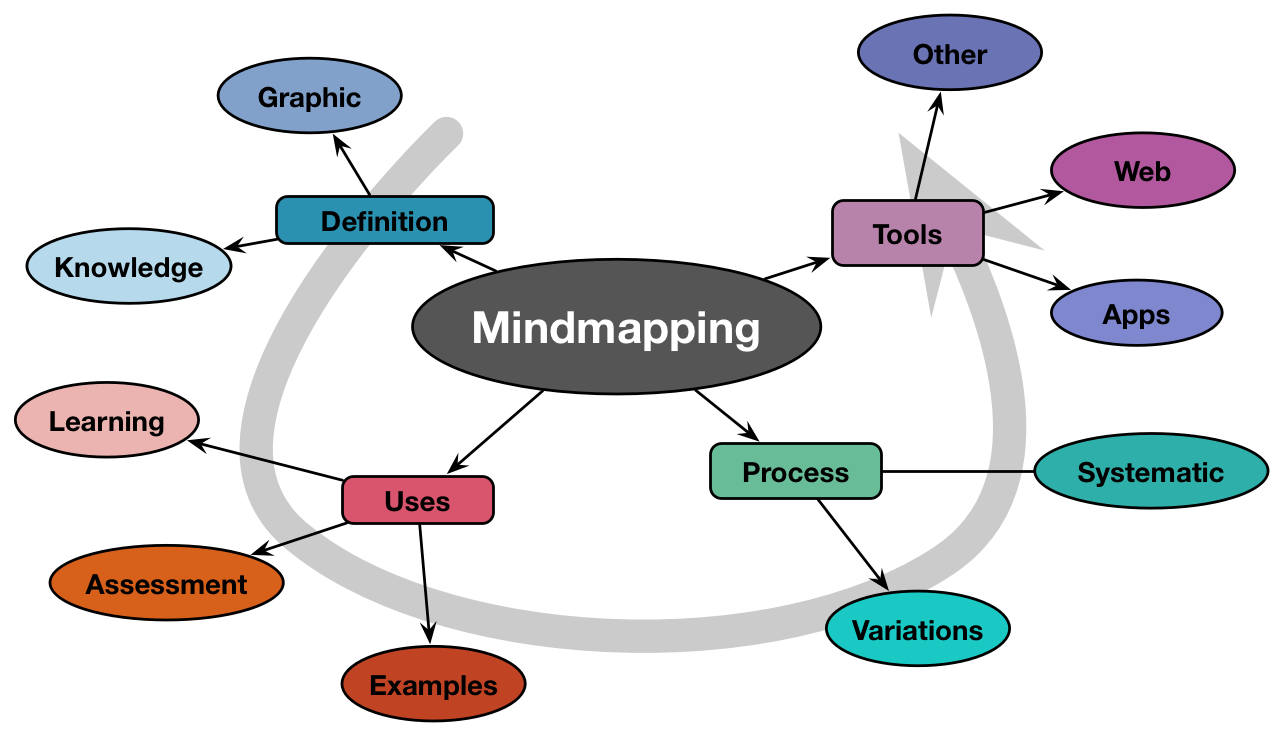 Home
Home  Note-Taking
Note-Taking  Studying
Studying  Organization
Organization  Time Management
Time Management  Useful Apps/Websites
Useful Apps/Websites  Picture Gallery
Picture Gallery  References
References  Stress
Stress  Subject-Specific Tips
Subject-Specific Tips
| Mind Mapping | ||
|---|---|---|
What is Mind Mapping? A mind map is a diagram used to visually organize information. A mind map is hierarchical and shows relationships among pieces of the whole. It is often created around a single concept, drawn as an image in the center of a blank page, to which associated representations of ideas such as images, words and parts of words are added. Major ideas are connected directly to the central concept, and other ideas branch out from those. Mind maps can be drawn by hand, either as "rough notes" during a lecture, meeting or planning session, for example, or as higher quality pictures when more time is available. Mind maps are considered to be a type of spider diagram. A similar concept in the 1970s was "idea sun bursting".
|
Steps to Mind Mapping:
|
 |
 |
||
| Cornell Notes | ||
| Steps to creating Cornell Notes:
Divide the Paper Into Three Sections:
Document:
Write Notes:
|
Review and Clarify:
Summarize:
Study Your Notes:
|
|
| Color-Coding | ||
Color-coding your notes can help you organize information more effectively and study more efficiently. Optimize your color-coding system and make it a highlight of your study strategy by using the five tips in this article.
Why color-code your notes? Color-coding is a dynamic way to organize the information that you need to learn. Even if you're short on study time, color-coded notes allow you to rapidly review the most important information. The use of bright colors captures your attention and is especially stimulating for visual learners. (If you're not sure what your learning style is, you can discover more about the concept in this Study.com lesson.) However, the colors are more than just eye-catching: The significance you give to each hue serves as a form of mental shorthand, giving context to the material you mark and helping you to process it more meaningfully and efficiently.
|
The Five Tips
Number 1: Color-Code after Initial Note-Taking You may be tempted to color-code your notes as you're taking them down during a class or a lecture. However, this can be counterproductive. Once you've finished taking notes, you can color-code them without interrupting the flow of information from a lecture or textbook. Color-coding after initial note-taking also gives you the opportunity to organize your notes and to review them as you do so. Number 2: Choose the Right Tools
|
Number 3: Be Consistent Whether it's red for main ideas, green for action items, or blue for facts and figures, always use the same colors throughout your notes to signify the same categories of information. Keep a table in the front of your notebook with a list of the categories and their corresponding colors. Try to use the same system for all of your classes to avoid confusion. The meanings of the individual colors will become second nature to you as you use them consistently. Number 4: Limit Your Color Palette Don't over-complicate your system by introducing more than three or four colors. In order to make sense of your color-coded notes, you will need to remember what each color means as you study. Choose highlighter colors that contrast with the text to make the words stand out. Stick to text colors that are easy to read against the page's background. Number 5: Use Color-Coding Judiciously Limit your use of color-coding to the most critical information. If everything is highlighted or colored, nothing will stand out as important. Think of color-coding like road signs: If there were too many road signs, you would be bombarded with too much information and you might even get lost. In the same way, too much color-coding can be distracting and lead to information overload. Remember that the goal of color-coding is to focus your attention and make your notes clearer and easier to navigate. Every color should serve a specific purpose and point you in the right direction. |
| Rewriting Notes | ||
Teachers often emphasize the information they provide in class lectures when they design tests. This means that your class notes are a vital resource when studying for a test. It is important that your class notes be complete and accurate. The best way to be certain that your class notes are complete and accurate is to review them in the evening while the information that was covered in class is still fresh in your mind. At this time you should rewrite your notes, correcting any errors, filling in any gaps, and adding additional information as appropriate. Rewriting your class notes also gives you the opportunity to improve their organization and to make them neater, thereby making your notes easier to study from. Further, rewriting your class notes reinforces the information so that you will remember it better.
|
Here are some tips to rewriting notes:
|
|
| Recorded Lessons | ||

